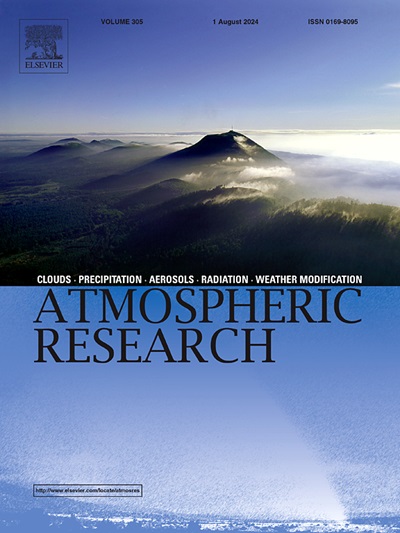Hourly calibration algorithm for Fengyun-2G quantitative precipitation estimates using spatial random forest and improved temporal disaggregation scheme
IF 4.5
2区 地球科学
Q1 METEOROLOGY & ATMOSPHERIC SCIENCES
引用次数: 0
Abstract
Fengyun satellite series offers Quantitative Precipitation Estimates (QPEs) with high spatiotemporal resolution, providing coverage at both regional and global scales. However, as indirect estimates of precipitation based on infrared data, Fengyun-2G (FY-2G) QPEs inherently contain considerable regional and seasonal uncertainties. In this study, to mitigate these errors, we propose a novel calibration algorithm that enhances the spatial and temporal performance of FY-2G QPE at both daily and hourly scales. This method consists of two components: first, a daily-scale spatial calibration using a multi-variable-assisted Random Forest (RF) technique, and second, an hourly-scale temporal calibration based on an Improved Proportional Factor (IPF) method, which refines traditional PF approaches by integrating Geographic Difference Analysis (GDA) and Inverse Distance Weighting (IDW) for error correction. The proposed approach was applied to generate a high-quality FY-2G precipitation dataset for the Chinese mainland (0.1°/hr, 2018–2019). Validation against the China Merged Precipitation Analysis (CMPA) dataset demonstrates significant improvements: Daily-scale spatial calibration using RF increases the correlation coefficient (CC) from 0.74 to 0.92 (+24.3 %), reduces BIAS from 15.69 % to 8.04 % (−48.8 %), and decreases RMSE from 5.97 mm to 2.93 mm (−50.9 %). Hourly-scale temporal calibration using RF-IPF improves CC from 0.47 (FY-2G) to 0.77, reduces BIAS from −36.73 % to 8.25 %, and lowers RMSE from 2.98 mm to 2.11 mm during extreme precipitation events. These results highlight the effectiveness of the proposed calibration framework in enhancing both spatial and temporal accuracy of infrared-based QPEs. Unlike existing methods that primarily focus on daily-scale corrections, our approach extends calibration to the hourly level, improving precipitation estimates crucial for short-duration extreme weather events. While this methodology is demonstrated in China, its framework can be adapted to other satellite-based precipitation datasets and applied across diverse climatic and topographic regions, providing valuable insights for hydrological and climatic research worldwide.
利用空间随机森林和改进的时间分解方案的风云二号 G 定量降水估算小时校准算法
本文章由计算机程序翻译,如有差异,请以英文原文为准。
求助全文
约1分钟内获得全文
求助全文
来源期刊

Atmospheric Research
地学-气象与大气科学
CiteScore
9.40
自引率
10.90%
发文量
460
审稿时长
47 days
期刊介绍:
The journal publishes scientific papers (research papers, review articles, letters and notes) dealing with the part of the atmosphere where meteorological events occur. Attention is given to all processes extending from the earth surface to the tropopause, but special emphasis continues to be devoted to the physics of clouds, mesoscale meteorology and air pollution, i.e. atmospheric aerosols; microphysical processes; cloud dynamics and thermodynamics; numerical simulation, climatology, climate change and weather modification.
 求助内容:
求助内容: 应助结果提醒方式:
应助结果提醒方式:


